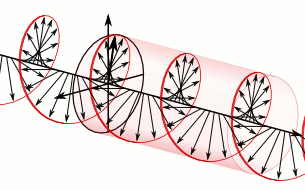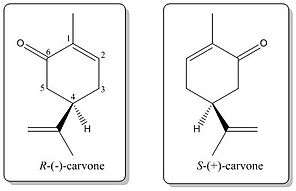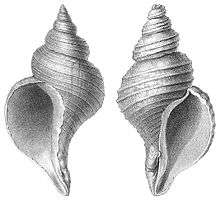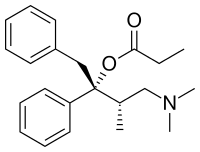Chirality

Chirality /kaɪˈrælɪtiː/ is a property of asymmetry important in several branches of science. The word chirality is derived from the Greek, χειρ (kheir), "hand", a familiar chiral object.
An object or a system is chiral if it is distinguishable from its mirror image; that is, it cannot be superposed onto it. Conversely, a mirror image of an achiral object, such as a sphere, cannot be distinguished from the object. A chiral object and its mirror image are called enantiomorphs (Greek, "opposite forms") or, when referring to molecules, enantiomers. A non-chiral object is called achiral (sometimes also amphichiral) and can be superposed on its mirror image. If the object is non-chiral and is imagined as being colored blue and its mirror image is imagined as colored yellow, then by a series of rotations and translations the two can be superposed producing green with none of the original colors remaining.
The term was first used by Lord Kelvin in 1893 in the second Robert Boyle Lecture at the Oxford University Junior Scientific Club which was published in 1894:
I call any geometrical figure, or group of points, 'chiral', and say that it has chirality if its image in a plane mirror, ideally realized, cannot be brought to coincide with itself.[1]
Human hands are perhaps the most universally recognized example of chirality. The left hand is a non-superimposable mirror image of the right hand; no matter how the two hands are oriented, it is impossible for all the major features of both hands to coincide across all axes.[2] This difference in symmetry becomes obvious if someone attempts to shake the right hand of a person using their left hand, or if a left-handed glove is placed on a right hand. In mathematics, chirality is the property of a figure that is not identical to its mirror image.
Mathematics


In mathematics, a figure is chiral (and said to have chirality) if it cannot be mapped to its mirror image by rotations and translations alone. For example, a right shoe is different from a left shoe, and clockwise is different from anti-clockwise.
A chiral object and its mirror image are said to be enantiomorphs. The word enantiomorph stems from the Greek ἐναντίος (enantios) 'opposite' + μορφή (morphe) 'form'. A non-chiral figure is called achiral or amphichiral.
The helix (and by extension a spun string, a screw, a propeller, etc.) and Möbius strip are chiral two-dimensional objects in three-dimensional ambient space. The J, L, S and Z-shaped tetrominoes of the popular video game Tetris also exhibit chirality, but only in a two-dimensional space.
Many other familiar objects exhibit the same chiral symmetry of the human body, such as gloves, glasses (where two lenses differ in prescription), and shoes. A similar notion of chirality is considered in knot theory, as explained below.
Some chiral three-dimensional objects, such as the helix, can be assigned a right or left handedness, according to the right-hand rule.
Geometry
In geometry a figure is achiral if and only if its symmetry group contains at least one orientation-reversing isometry. In two dimensions, every figure that possesses an axis of symmetry is achiral, and it can be shown that every bounded achiral figure must have an axis of symmetry. In three dimensions, every figure that possesses a plane of symmetry or a center of symmetry is achiral. There are, however, achiral figures lacking both plane and center of symmetry. In terms of point groups, all chiral figures lack an improper axis of rotation (Sn). This means that they cannot contain a center of inversion (i) or a mirror plane (σ). Only figures with a point group designation of C1, Cn, Dn, T, O, or I can be chiral.
Knot theory
A knot is called achiral if it can be continuously deformed into its mirror image, otherwise it is called chiral. For example, the unknot and the figure-eight knot are achiral, whereas the trefoil knot is chiral.
Physics

In physics, chirality may be found in the spin of a particle, where the handedness of the object is determined by the direction in which the particle spins.[3] Not to be confused with helicity (which is the projection of the spin along the linear momentum of a subatomic particle), chirality is purely quantum mechanical phenomenon (like spin). Although both can have left-handed or right-handed properties, only in the massless case they have a simple relation.[4] In particular for a massless particle the helicity is the same as the chirality while for an antiparticle they have opposite sign.
The handedness in both chirality and helicity relate to the rotation of a particle while it proceeds in linear motion with reference to the human hands. The thumb of the hand points towards the direction of linear motion whilst the fingers curl into the palm, representing the direction of rotation of the particle (i.e. clockwise and counterclockwise). Depending on the linear and rotational motion, the particle can either be defined by left-handedness (ex. translating leftwards and rotating counterclockwise) or right-handedness (ex. translating in the right direction and rotating clockwise).[5] A symmetry transformation between the two is called parity. Invariance under parity by a Dirac fermion is called chiral symmetry.
Electro-magnetism
Electromagnetic wave propagation as handedness is wave polarization and described in terms of helicity (occurs as a helix). Polarization of an electromagnetic wave is the property that describes the orientation, i.e., the time-varying, direction (vector), and amplitude of the electric field vector. For a depiction, see the adjacent image.
Chemistry

A chiral molecule is a type of molecule that has a non-superposable mirror image. The feature that is most often the cause of chirality in molecules is the presence of an asymmetric carbon atom.[6][7]
The term chiral in general is used to describe the object that is non-superposable on its mirror image.[8]
In chemistry, chirality usually refers to molecules. Two mirror images of a chiral molecule are called enantiomers or optical isomers. Pairs of enantiomers are often designated as "right-" , "left-handed" or if it has no bias achiral. As polarized light passes through a chiral molecule, the plane of polarization, when viewed along the axis toward the source, will be rotated in a clockwise (to the right) or counter-clockwise (to the left). A right handed rotation is dextrorotary (d); that to the left is levorotary (l). The d- and l-isomers are the same compound but are called enantiomers. A equi-molar mixture of the two optical isomers will produce no net rotation of polarized light as it passes through.[9] Left handed molecules are have l- prefixed to their names; d- is prefixed to right handed molecules.
Molecular chirality is of interest because of its application to stereochemistry in inorganic chemistry, organic chemistry, physical chemistry, biochemistry, and supramolecular chemistry.
Biology
All the known life-forms show specific chiral-properties in chemical-structures as well as macroscopic anatomy, development and behavior. For all-set of organism or a small-set of organism, certain compound or organ or behavior, always found in 1 specific enantiomorphic form (out of 2). Deviation (having the opposite-form) could be found in small-number of chemical-compounds, or certain organ or behavior but that-variation strictly depends upon the genetic make-up of the organism. From chemical-level (molecular scale), biological systems show extreme stereo-specificity in synthesis, uptake, sensing, metabolic processing . A living system usually deals with 2 enantiomers of same-compound in a drastically different way.
In biology, homochirality is a common property of amino acids and carbohydrates. The protein-making amino-acids, (that are translated through ribosome from genetic coding) occur in L form (except glycine, which is achiral, has two indistinguishable hydrogen atoms on the alpha carbon). However, D-amino acids are also found in nature. The monosaccharides (carbohydrate-units) are commonly found in D-configuration. DNA double-helix is chiral (as any-kind of helix is chiral), and B-form of DNA shows a right-handed turn.
Sometimes, when 2 enantiomers of a compound found in organisms, they significantly differ in their taste, smell and other biological actions. For example, (+)-Limonene found in orange (causing its smell), and (-)-Limonene found in Lemons (causing its smell), show different smells[10] (different biochemical interaction at human nose). (+)Carvone is responsible for the smell of Caraway seed oil, and (-)Carvone is responsible for smell of Spearmint oil.[11]

| Limonene from Lemon and Orange. | ||||
|---|---|---|---|---|
|
Also, for artificial compounds, including medicines, in case of chiral-drugs, the 2 enantiomers show remarkable effect in difference of their biological actions. Darvon (Dextropropoxyphene) is a painkiller, whereas its enantiomer, Novrad (Levopropoxyphene) is an anti-cough agent. In case of Penicillamine, the S-isomer used in treatment of primary chronic arthritis, Whereas the R-isomer has no therapeutic effect as well it is highly toxic.[12]
| Dextropropoxyphene and Levopropoxyphene | ||||
|---|---|---|---|---|
|
Macroscopic example of Chirality is found in plant-kingdom, animal-kingdom and all-other groups of organism.

A simple example is the coiling-direction of any climber-plants. It maybe 1 of 2 possible type of helix.

In anatomy, chirality is found in the imperfect mirror-image symmetry of many kinds of animal bodies. Organisms such as gastropods exhibit chirality in their coiled shells, resulting in an asymmetrical appearance. Over 90% of gastropod species [13] have dextral (right-handed) shells in their coiling, but a small minority of species and genera are virtually always sinistral (left-handed). A very few species (for example Amphidromus perversus[14]) show an equal mixture of dextral and sinistral individuals.
In humans, chirality (also referred to as handedness or laterality) is an attribute of humans defined by their unequal distribution of fine motor skill between the left and right hands. An individual who is more dexterous with the right hand is called right-handed, and one who is more skilled with the left is said to be left-handed. Chirality is also seen in the study of facial asymmetry.
In flatfish, the Summer flounder or fluke are left-eyed, while halibut are right-eyed.
See also
- Asymmetry
- Handedness
- Orientation (mathematics)
- Right-hand rule
- Sinistral and dextral
- Stereochemistry
- Tendril perversion
References
- ↑ Sir William Thomson Lord Kelvin (1894). "The Molecular Tactics of a Crystal". Clarendon Press.
- ↑ Georges Henry Wagnière, On Chirality and the Universal Asymmetry: Reflections on Image and Mirror Image (2007).
- ↑ http://discovermagazine.com/1995/nov/lookingfortherig591
- ↑ http://www.quantumdiaries.org/2011/06/19/helicity-chirality-mass-and-the-higgs/
- ↑ http://www.quantumdiaries.org/2011/06/19/helicity-chirality-mass-and-the-higgs/
- ↑ Organic Chemistry (4th Edition) Paula Y. Bruice.
- ↑ Organic Chemistry (3rd Edition) Marye Anne Fox ,James K. Whitesell.
- ↑ IUPAC, Compendium of Chemical Terminology, 2nd ed. (the "Gold Book") (1997). Online corrected version: (2006–) "chirality".
- ↑ Chang, Raymond. Chemistry (second ed.). Random House. p. 660. ISBN 0-394-32983-X.
- ↑ Solomon and Fryhles organic chemistry, Ed 10, Wiley (Students edition), Chapter 5 (Stereochemistry), Section 5.5 More about biological significance of chirality
- ↑ Solomon and Fryhles organic chemistry, Ed 10, Wiley (Students edition), Chapter 5 (Stereochemistry), review problem 5.14
- ↑ Solomon and Fryhles organic chemistry, Ed 10, Wiley (Students edition), Chapter 5 (Stereochemistry), section 5.11(chiral drugs)
- ↑ Schilthuizen, M.; Davison, A. (2005). "The convoluted evolution of snail chirality". Naturwissenschaften. 92 (11): 504–515. doi:10.1007/s00114-005-0045-2.
- ↑ Amphidromus perversus (Linnaeus, 1758)
External links
- The Handedness of the Universe by Roger A Hegstrom and Dilip K Kondepudi http://quantummechanics.ucsd.edu/ph87/ScientificAmerican/Sciam/Hegstrom_The_Handedness_of_the_universe.pdf
| Look up chirality in Wiktionary, the free dictionary. |



